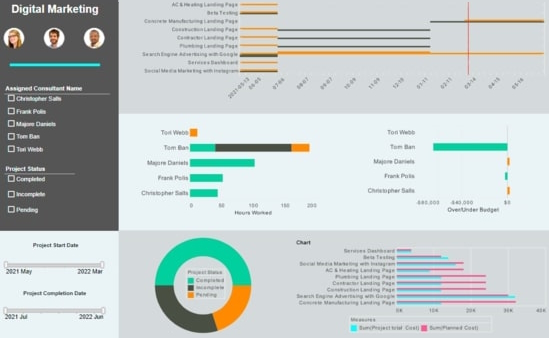Project Reporting Tools
Effective project reporting is essential for an organization's progress and should be implemented at all levels ranging from employees to owners and executives. The right status reporting software will make it easy to keep all of an organization's activities in check.
Project managers foremost need project progress and coordination information such as dashboards displaying Gantt charts (see dashboard example).
However, the dashboards and reports must be able to go beyond core project management data to give a holistic view of all factors that can impact on-time, on-budget delivery.
Benefits of Project Reporting with InetSoft
Project status reporting represents the critical reporting relationship between project managers and employees, as well as managers and executives. Using an agile status reporting tool such as InetSoft's Style Intelligence provides users an efficient platform to create reports and keep management updated on company and employee progress.
Project managers interact, share and collaborate with many parties. Visualization dashboards works excellently in most cases. Offline distributable reports become essential for many occasions where parties must share a large amount of information. InetSoft's pixel perfect, paginated document report engine is specifically designed for these cases.
Visualization dashboards are the most intuitive ways to understand project information. However, not all dashboards are created equal. InetSoft's web app can easily connect to project management data to create self-service dashboards with rich built-in interactivity and customization.
For successful delivery of projects, project managers must utilize all project related data, for example, supply chain and issue tracking system data. These systems are normally scattered. Some third party data may even be in Excel files. InetSoft's data mashup makes data processing a light-weight, business user self-serviceable process with great efficiency.
How an Industrial Textile Recycler Switched from Wrike to StyleBI for Project Reporting
The industrial textile recycling industry is an area where businesses specialize in reclaiming, reprocessing, and repurposing industrial-grade textiles such as safety gear, conveyor belts, and protective fabrics. These companies face complex challenges: managing projects that involve massive supply chains, strict compliance standards, and the integration of data from different industrial clients. A mid-sized firm in this industry, which we will call EcoReclaim Textiles, had been using Wrike for project reporting but found the tool limiting when it came to data analysis and long-term strategic insights. The decision to migrate to StyleBI as their new project reporting solution represents a transformative shift for the company, enabling it to better manage projects, optimize resources, and unlock deeper value from its operations.
The Industry Context and Project Complexity
The industrial textile recycling industry may not be in the public eye, but it is highly intricate. EcoReclaim Textiles handles dozens of simultaneous projects, ranging from small-scale fabric recovery for local manufacturers to large, multinational recycling contracts that involve multiple stakeholders, specialized transport systems, and regional compliance reporting. Each project requires strict milestone tracking, transparent communication with clients, and accurate financial reporting. Wrike initially helped them stay organized by providing task management, collaborative spaces, and standard dashboards. However, as the company grew and entered into larger contracts, Wrike’s limitations began to surface. It could manage tasks and timelines, but it struggled when the company required advanced data mashups, multi-dimensional analysis, and reporting that spanned not just project timelines but also supply chain, compliance, and financial performance.
EcoReclaim’s leadership realized that project reporting in their industry wasn’t simply about tracking whether a task was completed on time. Instead, it was about understanding broader metrics: how much material was reclaimed, the efficiency of specific recycling processes, turnaround times for client requests, and compliance with environmental regulations. Wrike could provide surface-level project visibility but did not offer the analytical depth that would drive operational improvements. StyleBI, on the other hand, was designed not just as a reporting platform but as a full business intelligence environment. It became clear that adopting StyleBI would allow EcoReclaim to elevate its project reporting into something more strategic.
Limitations of Wrike for EcoReclaim’s Needs
While Wrike was sufficient in the early days, several issues started to frustrate project managers and executives alike. First, Wrike’s reporting was relatively static. It could create reports on project progress, timelines, and team workload, but deeper insights—such as trends across projects or correlations between supply delays and final profitability—were not easily extracted without exporting data into other tools. Second, Wrike’s dashboards lacked the flexibility to integrate external data sources. EcoReclaim often needed to bring in data from ERP systems, environmental compliance trackers, and third-party logistics providers. Wrike was never designed for that level of integration. Third, as projects grew in size and complexity, the cost of customizing Wrike and maintaining it for these use cases became prohibitive. It was evident that Wrike was a solid project management platform but not the right solution for an industry where project reporting demanded analytical power.
The Switch to StyleBI
When EcoReclaim evaluated StyleBI, the differences were striking. Unlike Wrike, which was built around task management and project execution, StyleBI was built around data. It allowed the company to mash up data from multiple sources—ERP, supply chain logistics, environmental reporting systems, and even customer feedback surveys—into a single reporting framework. This made it possible to create dashboards and scorecards that reflected not only project milestones but also the broader ecosystem in which each project operated.
For example, StyleBI dashboards could track the volume of recycled textiles processed against project timelines, linking that to profitability metrics and compliance KPIs. Executives could immediately see whether delays in transport were eroding margins or whether new recycling methods were improving efficiency. This multi-dimensional reporting capability was exactly what EcoReclaim needed to turn project reporting from a reactive tool into a proactive strategic driver.
Benefits Realized After the Migration
One of the most immediate benefits EcoReclaim experienced after switching to StyleBI was improved visibility. Project managers could now drill down into data far beyond surface-level Gantt charts. They could analyze historical trends to forecast future bottlenecks, measure how often certain types of delays occurred, and identify recurring issues across clients or facilities. This helped the team anticipate problems before they escalated.
Another significant improvement came from financial integration. With StyleBI, EcoReclaim was able to blend project reporting with cost data from its ERP system. This made it possible to see not just whether a project was on schedule but also whether it was on budget in real time. The leadership team could instantly identify which projects were more profitable and which were at risk of slipping into losses. Wrike had never offered that level of integration or visibility, leaving managers to patch together information manually from different systems.
Perhaps the most transformative change was in client communication. EcoReclaim could now share live dashboards with clients, giving them transparency into progress, compliance reporting, and environmental impact. This built trust and positioned EcoReclaim as a partner that valued transparency and accountability. In an industry where reputation matters deeply and contracts can span years, this transparency became a differentiator that helped them win new business.
Challenges During the Transition
Of course, the migration from Wrike to StyleBI was not without challenges. Project managers who were accustomed to Wrike’s simple task interface initially found StyleBI more complex. The IT team needed to set up data connections and train managers on how to interpret multi-dimensional dashboards. Additionally, the migration required a cultural shift: project reporting was no longer just the domain of project managers but also of data analysts and executives who had a more hands-on role in interpreting results.
However, the company managed these challenges by investing in training and by gradually rolling out StyleBI dashboards across departments. Wrike was phased out slowly, with some teams running parallel reporting systems for a time until they felt comfortable. Over the course of six months, StyleBI became the central reporting hub, and Wrike was retired completely.
Why StyleBI Is a Better Fit
The decision to move away from Wrike was not simply about dissatisfaction but about alignment. Wrike is an excellent platform for traditional project management, but EcoReclaim’s industry demanded more than task tracking—it demanded intelligence. StyleBI offered the ability to look beyond deadlines and tasks into performance, efficiency, and profitability. It empowered EcoReclaim to see the bigger picture, optimize resource use, and continually refine its processes. The obscure but vital industry of industrial textile recycling is full of hidden complexity, and StyleBI gave EcoReclaim the tools to master it.
Looking Ahead
With StyleBI fully implemented, EcoReclaim is now exploring predictive analytics. Instead of only reporting on past and current projects, they want to use StyleBI to predict which clients are most likely to request additional services, which suppliers might cause delays, and where new efficiencies can be gained. The ultimate goal is not only to report but also to forecast, moving project reporting into the realm of business foresight.
In the long run, this shift has positioned EcoReclaim not only as a more efficient operator but also as an innovator in its niche. StyleBI has become more than just a reporting tool—it is a strategic platform that enables EcoReclaim to thrive in an industry that demands both operational discipline and adaptability. The journey from Wrike to StyleBI highlights a lesson applicable to many companies: the right project reporting tool isn’t just about managing tasks; it’s about unleashing insight. For EcoReclaim, that insight is helping them recycle not just textiles, but also outdated ways of managing projects, replacing them with data-driven strategies fit for the future.




